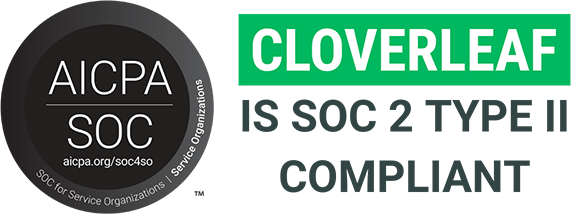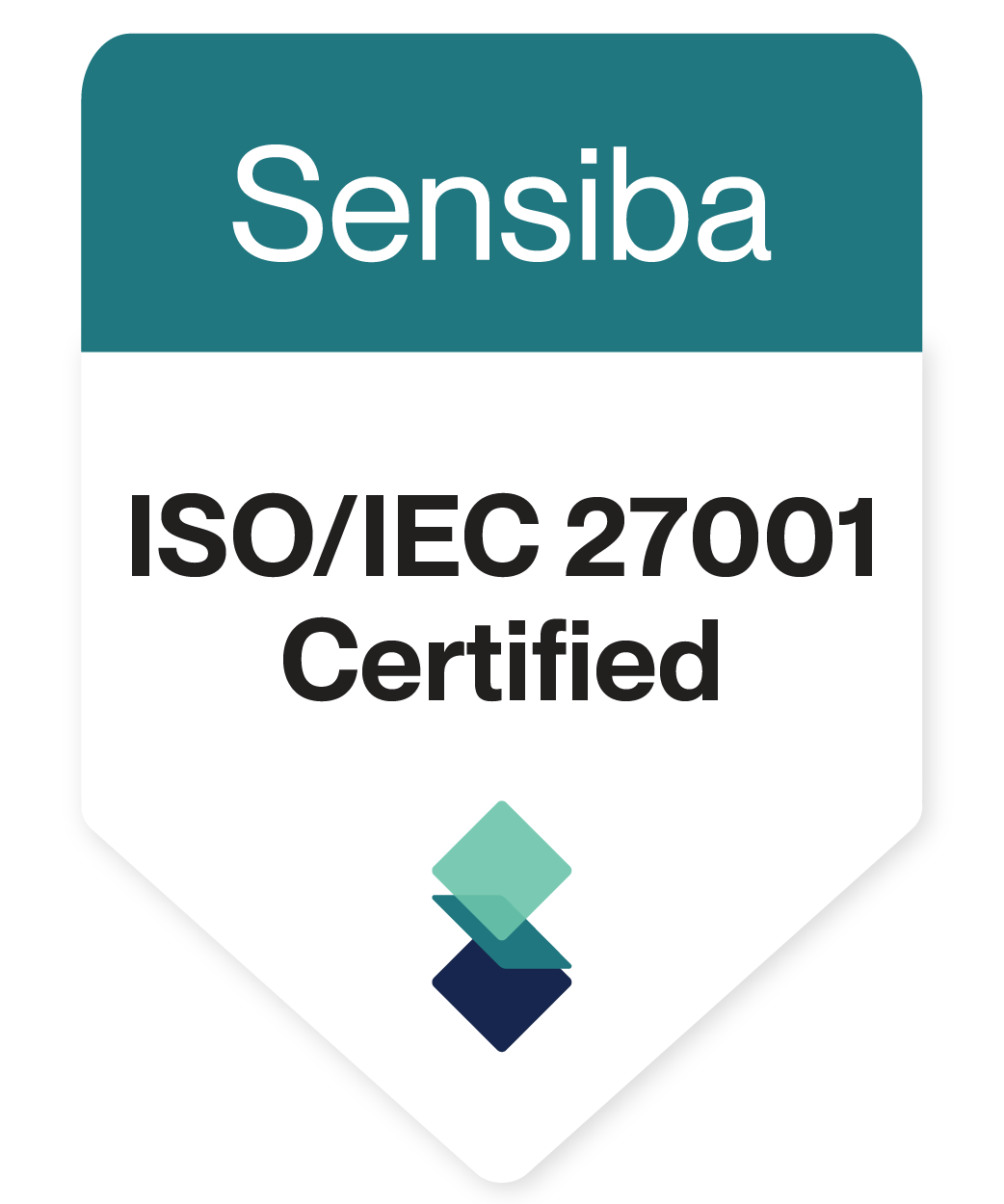For today’s Talent Development Leaders, a disruption is reshaping how we think about people development strategies. Employee growth is not solely limited to yearly workshops or exclusive coaching for senior leadership. The conversation is now focused on scalability, personalization, and continuous learning—concepts that may sound familiar but have only recently become truly feasible thanks to technological advancements.
Leaders in this space understand the stakes: retention, engagement, and performance all hinge on effective development programs. Yet many established models, even those grounded in popular platforms like BetterUp, Torch, and Coachello, often struggle to evolve beyond traditional variations of scheduled learning frameworks. While these platforms are robust and helpful in certain applications, they lean heavily on episodic coaching or leadership-centric models, which sometimes miss the nuanced needs of an entire organization.
What’s the Missing Piece?
If you’re already invested in people development, you’ve likely noticed the growing array of tools and platforms designed to support your efforts.
So, why explore further?
Because the way we approach development is shifting rapidly, and your organization’s needs are evolving just as quickly. The future isn’t just about scaling what already works; it’s about reimagining how development can happen in the flow of work, in real-time, for everyone—from individual contributors to the C-suite.
The tools available today—whether it’s BetterUp’s well-being-focused coaching(Josh Bersin), Torch’s integration of mentoring(Torch), or Leadr’s personal development plans for leadership—offer a range of solutions designed to meet different aspects of people development. (SourceForge)
But here’s the question: How are these platforms addressing the broader, systemic need for behavior change? There’s a difference between development that’s personalized in theory and personalized because it is unique to the person, contextual, and in real time within in the flow of work.
Speaking of that, what does everyone even mean when we talk about things like:
Coaching for Everyone
Sure, many platforms promise scalable coaching, but is it really reaching everyone in a meaningful way, or is it still reserved for high performers and leadership?
Learning in the Flow of Work
We hear this phrase everywhere, but how often is it executed well? Is development truly woven into work, or does it still require stepping away from productivity to make time for learning?
Personalization
All platforms claim personalization, but how deep does it go? Is the content tailored based on role and department, or does it adjust dynamically based on real-time team interactions and individual needs?
Measuring Impact
It’s easy to track engagement or satisfaction scores, but are you able to clearly see how development impacts business outcomes like retention, team performance, and communication?
AI in Coaching
AI sounds great, but how is it actually being used? Is it helping match users with coaches, or is it going a step further—delivering real-time, adaptive coaching insights based on day-to-day challenges?
Is there more to development than scheduled coaching sessions or leadership-focused programs? As we look to the future, the challenge isn’t just about providing access to coaching—it’s about integrating development into the everyday moments that shape team dynamics, decision-making, and performance.
Automated Coaching™ is designed with this in mind, offering more than LMS style learning, content libraries, role based suggestions, or episodic mentoring. It provides real-time, micro-coaching nudges, customized to your team’s unique dynamics and each individual’s specific needs.
If your current tools have been effective, that’s fantastic. But consider this: Are there advanced capabilities that today’s technology can unlock to make your talent development efforts even more impactful
By the end of this article, you’ll see not only how platforms like BetterUp, Torch, and Coachello contribute to the development space but also why Automated Coaching’s approach is different. It’s a new standard for people development—deeply personal, immediate, embedded, and scalable.
See How Cloverleaf Makes Peopled Development Scalable
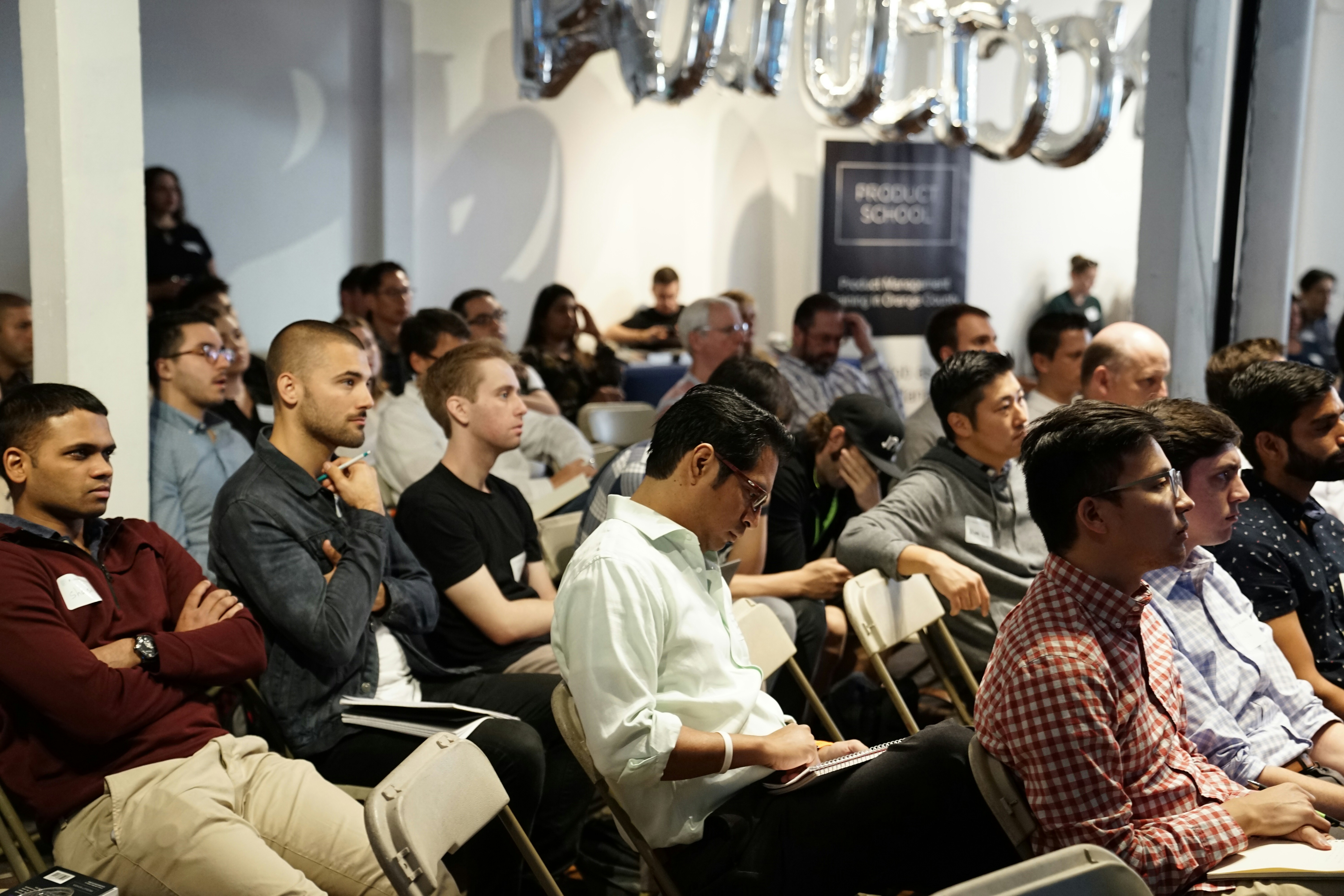
What Are The Actual Barriers Blocking People Development?
It’s easy to assume the barriers to effective people development are surface-level—limited budgets, lack of time, or employee disengagement. But for many Talent Development Leaders, these challenges often mask deeper, systemic issues that are much harder to spot. What if the real obstacles aren’t what we think they are?
Leaders often focus on getting the right tools or securing leadership buy-in, but the true barriers could be how development programs are structured and delivered. For example, we might blame low engagement on lack of motivation, but the root cause could be the disconnect between training and application in the real world of work. Is your development program really embedded in the day-to-day workflow, or is it an isolated initiative? Are you scaling growth for everyone or only offering personalized coaching to a select few?
The real problem may not be in common approaches to measuring success but in how deeply development is embedded into the culture and workflow of an organization. Understanding these underlying barriers is the first step in creating solutions that work in theory and practice.
1. Truly Personalized Learning
While many platforms promise personalized development, most rely on generalized, role-based content that doesn’t account for the individual’s contextual needs, strengths, or challenges. This one-size-fits-all approach results in development that is actually impersonal and disconnected from the day-to-day experiences of employees.
2. Disruptive Learning Opportunities
Development often happens in isolated bursts—through annual workshops or sporadic coaching sessions—leaving employees without the continuous reinforcement they need to apply new skills or change behaviors over time. Without ongoing learning, development is confined to one-off event rather than an embedded growth process. Employees need learning delivered in manageable doses that align with their daily responsibilities to drive growth.
3. Limited Resources
Scaling development across an entire organization is no easy feat. Due to time constraints, budget, and resources, most organizations struggle to offer individualized coaching at scale. The challenge lies in extending meaningful development opportunities to everyone without sacrificing quality.
4. Proving Impact
Leaders often struggle to connect development programs to measurable business outcomes like retention, performance, or collaboration. Satisfaction surveys or engagement metrics might provide some insight, but they don’t capture the real impact of people development efforts, making it difficult to justify ongoing investment.

What People Development Software Are We Talking About?
BetterUp: A Market Leader Focused on Well-Being and Leadership
BetterUp is a leading platform in well-being and leadership development. It focuses on combining personal growth with professional effectiveness. The platform offers flexible learning paths with 1:1 coaching, allowing users to work on personalized goals while improving mental fitness.
Torch: Mentoring and Coaching For Leadership Development
Torch is a platform that focuses on leadership development through a blend of 1:1 coaching and mentoring. By leveraging behavioral science and feedback loops, Torch aims to align leadership coaching with key business outcomes.
Coachello: AI-Powered Coach Matching and Asynchronous Support
Coachello focuses on providing AI-driven service to match team members with ICF certified coaches to offer asynchronous coaching through familiar workplace apps.
Cloverleaf: It’s Not A Chatbot Or Human Coach. It’s Automated Coaching.
Automated Coaching™ offers personalized, on-demand coaching at the moment it’s needed, tailored to who you are and where you are. Team members receive immediate insightful nudges that are specific to their current needs, team dynamics, and individual strengths. Available in workplace tools to impact areas central to quality teamwork and performance.
What Makes Each Platform Different?
If the barriers to people development revolve around personalization, continuous learning, scalability, and proving impact, it’s essential to understand how each platform tackles these challenges. By exploring how BetterUp, Torch, Coachello, and Cloverleaf approach these key pillars, you’ll be able to evaluate which solution best aligns with your organization’s needs for effective development.
1. Personalization
BetterUp offers 1:1 coaching, matching users with a coach based on detailed assessments. This ensures that each leader receives guidance tailored to their unique leadership style, needs, and goals. These assessments allow for a customized experience, although the content, delivered through the platform’s video library and assessments, is often triggered by role-based changes.
Torch provides 1:1 coaching where users are matched with a coach based on job experience, demographics, and individual preferences. Its algorithm ensures a 96% success rate for coach matching, allowing participants to connect with coaches who meet their specific needs and goals. While the focus is on leadership coaching, the platform also incorporates learning materials based on behavioral science and user feedback.
Coachello’s AI-powered platform recommends coaches for 1:1 coaching based on an intake self-assessment, allowing for a coaching journey that aligns with their development goals around specific soft skills. Participants can also select coaches manually based on preferences.
Cloverleaf provides accurate, layered insight that are based on each person’s unique psychometric data and the specific individuals a team member interacts with daily. Each coaching moment is not only customized to an individual’s strengths but also contextually relevant to their current team dynamics and relationships.
2. Continuous Learning
BetterUp integrates a program-driven approach with ongoing learning opportunities. The platform offers 1-2 minute videos and monthly content updates through both self-guided learning paths and instructor-led sessions so that users receive fresh content relevant to their roles. This structure provides a steady flow of new ideas from a content library to emerging and established leaders. BetterUp’s model allows users to choose when they engage with content, whether through individual coaching, group sessions, or self-directed pathways.
Torch allows participants to access both asynchronous coaching and live 1:1 video sessions through various formats, such as drop-in coaching, one-on-one sessions, and group mentoring. Torch also tailors development programs to each organization’s unique values and competencies, aligning coaching with business strategy.
Coachello offers 6-8 session-based coaching programs, which focus on objective-driven paths. Participants follow development journeys with clear, outcome-based goals that help them progress in areas like leadership or personal development.
Cloverleaf integrates coaching into daily tools like Slack, Microsoft Teams, email, and calendars, ensuring employees receive real-time, situational coaching without needing to leave their workflow. With unlimited, daily access to short, actionable tips (1-2 sentences), employees get immediate insights tailored to their specific tasks and team dynamics. Whether preparing for a meeting or working with teammates, coaching is timely, specific, and always available, making learning a seamless part of everyday work.
3. Scalability
BetterUp has delivered over 2 million coaching sessions since its inception, making it one of the largest people development software available. User can experience a blended assortment of coaching based on their specific leadership assessments and according to their role. The platform delivers coaching either in-person or via video, providing flexibility in how sessions are conducted.
Torch provides a configurable platform to help organizations design coaching and mentoring programs. It offers multiple coaching formats—1:1 coaching, group mentoring, and collaborative learning—which can be expanded across leadership levels, from emerging leaders to executives.
Coachello can connect a broad range of employees, from emerging leaders to senior executives, with 1:1 coaching opportunities. They use AI-driven technology to match participants with coaches efficiently.
Cloverleaf starts at ($13 per user) with unlimited access for each person to make development for everyone a real possibility, not just high level leaders or departments. By creating a common language through psychometric assessments and coaching insights teams can address challenges collectively and unify personal development into a shared experience.
4. Proving Impact
BetterUp frames its approach to proving impact by focusing on three primary business outcomes: Performance, Retention, and Well-Being. Its impact is centered around leadership development and mental health outcomes and its link to broader business success.
Torch measures impact by providing pre-built reports that track metrics like sentiment, satisfaction, and engagement, while using impact surveys and peer feedback to assess the influence on work performance. With additional tools like retention analysis, user-level engagement reports, and 360-degree feedback.
Coachello measures impact by using sentiment scores, surveys, and business insights to track progress in areas such as retention, performance, sales growth, and career transitions.
Cloverleaf measures growth in competencies of communication, teamwork, and collaboration. The platform also monitors engagement and usage, helping leaders understand how often coaching is used and which assessments are being taken.
Aligning The Right Tool With Your People Development Needs
Each platform—BetterUp, Torch, Coachello, and Cloverleaf—offers unique ways of delivering personalization, continuous learning, scalability, and impact measurement, but how they meet these needs differ significantly.
BetterUp focuses on 1:1 coaching matched through detailed assessments to support personal growth and mental fitness. Its model is structured around scheduled sessions and content libraries concerning development goals. It may work for organizations that want dedicated coaching, but it may still be challenging to accelerate behavior change and learning into the daily workflow.

Torch provides a combination of mentorship and coaching to align leadership development with business outcomes. The platform focuses on organizations that measure progress using sentiment and feedback surveys, but its emphasis may lean more toward structured leadership programs rather than scalable spontaneous learning moments.
Coachello uses AI to match team members with coaches to facilitate asynchronous coaching via workplace apps. Consider whether its asynchronous nature aligns with your team’s requirement for in-depth, interactive coaching or the ability to scale to each person.’

Cloverleaf offers something different: deeply personalized, automated coaching embedded into daily workflows through tools like Slack and email. Cloverleaf personalizes coaching based on psychometric data and the specific team dynamics, providing coaching at the moment it’s most relevant. This makes it particularly powerful for organizations looking for continuous, scalable development integrated into everyday work.
Automated Coaching Is A Different Approach To People Development
Automated Coaching is a different approach for organizations needing scalable, continuous, and deeply personalized development for people at all levels. Its affordable, unlimited access model, combined with psychometric-based insights, ensures that development is accessible to everyone while driving measurable behavioral change in key areas like communication, teamwork, and collaboration. Cloverleaf offers a unique, shared learning experience that transforms how teams communicate, collaborate, and grow.
Take the Next Step Toward Developing Your People
Want to offer personalized, real-time development for your entire team? Cloverleaf makes coaching accessible to every employee, every day—empowering them with insightful, context-specific coaching delivered right within the tools they already use. No more waiting for scheduled sessions or high-cost coaching reserved for leadership—Cloverleaf drives continuous learning in the flow of work.
Every day, you and your team navigate the complexities of training. It’s challenging because scheduling workshops or other designated times for learning pull employees away from their work.
The reality is that our brains struggle to retain information from one-time sessions, conversations, or readings. Despite our best efforts, most of what is learned in these settings is quickly forgotten. This isn’t due to a lack of engagement or interest; it’s simply how our brains function.
For learning to truly stick and be applied effectively in the right situations, continuous reinforcement is essential. However, Talent Development professionals can’t be present in every situation to ensure concepts are reinforced. Managers often lack the tools and expertise to effectively embed these learnings into daily work routines. This gap highlights the need for a new approach to development—one that integrates learning seamlessly into the flow of work, providing ongoing, relevant reinforcement exactly when it’s needed.
What if learning didn’t require stepping away from work but instead enhanced it? People need insights and development opportunities to appear organically within their workflow so that learning is continuous, contextual, and immediately relevant. This approach not only respects the demands on your team’s time but also ensures that development is a natural part of their daily routine.
Why should productivity and personal development compete? In this article, we’ll explore the possibility of integrating learning into daily activities to help resolve the tension that can arise between prioritizing productivity and development.

The Development/Productivity Paradox
Employees often see development as a distraction from their core responsibilities, viewing training as an interruption rather than an enhancement. This perception highlights the development/productivity paradox.
The 70-20-10 model reveals that effective growth happens when learning is integrated into daily tasks. Learning must be embedded into the workflow so that development becomes a natural extension of daily work. Continuous reinforcement ensures that new knowledge is immediately applied so that retention and meaningful behavior change occur.
The Challenges of Traditional Learning Methods
The Old Way Isn’t Working: 4 Common Pitfalls of Traditional Learning Strategies Traditional learning methods often fail to deliver sustainable results for several reasons. Workshops and training sessions, while well-intentioned, pull employees away from their daily tasks, creating disruption and information overload.- Disruption of Workflow: Scheduled sessions interrupt the flow of daily work, causing productivity dips and backlog. This disruption makes it challenging for employees to balance their work responsibilities with learning commitments.
- Information Overload: Large volumes of information delivered in a short period can overwhelm employees, leading to poor retention. Studies show that within one hour, learners forget an average of 50% of the information presented; within 24 hours, they forget 70%, and within a week, they forget up to 90% (Bridge) (Indegene).
- One-Size-Fits-All Approach: Generic training content, normally only specific to roles often fails to address the specific needs and contexts of individual employees. This lack of personalization reduces the effectiveness of learning interventions.
- Lack of Continuous Reinforcement: Without ongoing support, the skills and knowledge gained in one-time sessions quickly fade. Continuous reinforcement is essential for retention and application of new skills.
What Do These Gaps Mean
- Retention Rates: According to research, learners forget approximately 70% of new information within 24 hours and 90% within a week without reinforcement (Indegene). This highlights the need for continuous learning strategies to ensure knowledge retention.
- Engagement Levels: A LinkedIn Learning report found that 58% of employees prefer to learn at their own pace and on-demand, rather than in structured, time-bound sessions (SHIFT). This preference indicates a need for more flexible and personalized learning solutions.
- Impact of Microlearning: Microlearning, which delivers content in short, focused bursts, has been shown to boost retention rates by 25% to 60%. It also boasts an average completion rate of 82%, making it a highly effective method for engaging learners and improving retention (SHIFT).
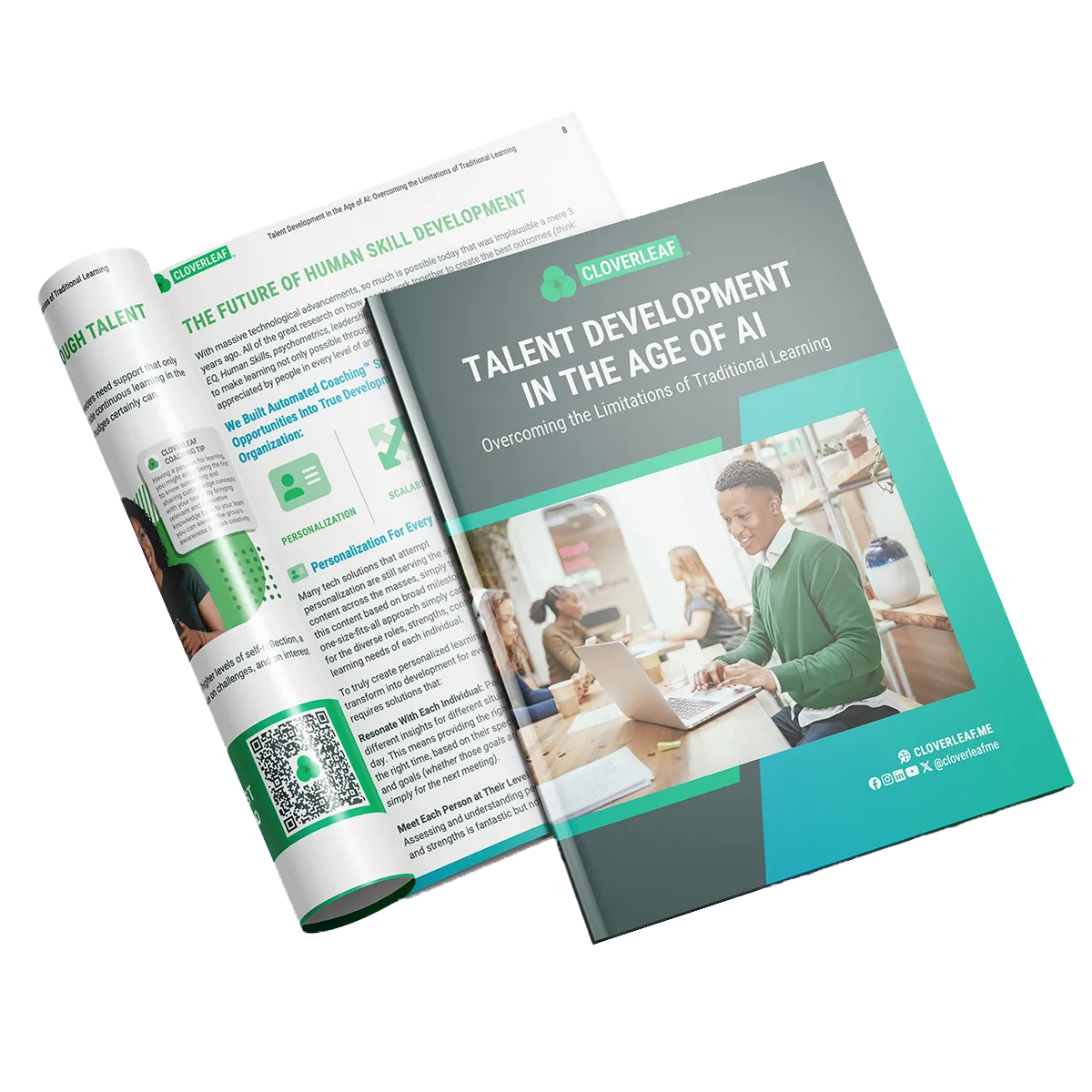
HUMAN SKILL PROGRAMS ARE HITTING LIMITATIONS...
Get Strategies To:
- Close the gap between learning and on-the-job application
- Overcome the tension of pausing productivity for development opportunities
- Experience done for you learning in the flow of work
- Stay ahead of human skill development
- Prove the ROI of your talent development programs

What Makes Continuous Learning Effective For An Organization?
Continuous learning means embedding development opportunities directly into the daily workflow. This approach ensures that learning is contextual, personalized, and integrated into the tools employees are already using every day, such as Slack, Microsoft Teams, email, and others. The goal is to make learning a natural, seamless part of the workday, providing real-time, situational coaching that is immediately relevant and actionable.
3 Components That Make Continuous Learning Possible
1. Ongoing Learning Opportunities:
Learning should not be a one-time event but an ongoing process. Continuous learning opportunities ensure that employees can regularly reinforce and build upon their knowledge and skills. Integrating learning directly into daily tools and routines provides constant reinforcement without disrupting workflow.
- Example: Imagine a project manager receiving daily insights not just on generic leadership skills but specific, personalized guidance on how to best collaborate with individual team members based on their unique personalities and work styles. For instance, they might receive a tip about leveraging the analytical skills of a detail-oriented team member during a planning meeting.
2. Personalized, Contextual Insights:
Providing insights tailored to individual needs and specific situations helps ensure that the learning is relevant and immediately applicable. Personalized coaching can address unique challenges and leverage individual strengths. Cloverleaf’s Automated Coaching™ delivers personalized, context-specific tips that are tailored to the unique psychology and interactions of each user.
- Example: Imagine a team lead receiving real-time, personalized advice on how to approach a one-on-one meeting with a particular team member. The coaching might suggest ways to motivate that team member based on their personality type, such as recognizing their achievements in a way that aligns with their need for validation.
3. Integration with Daily Tools:
By embedding learning into tools that employees already use the development process becomes a seamless part of their daily workflow. This integration minimizes disruption and maximizes the relevance and impact of the learning.
- Example: Consider a team receiving coaching tips and developmental insights directly in their workplace tools. For instance, a Slack notification might suggest adjusting communication approaches for an upcoming meeting with a team member who prefers concise, data-driven discussions.
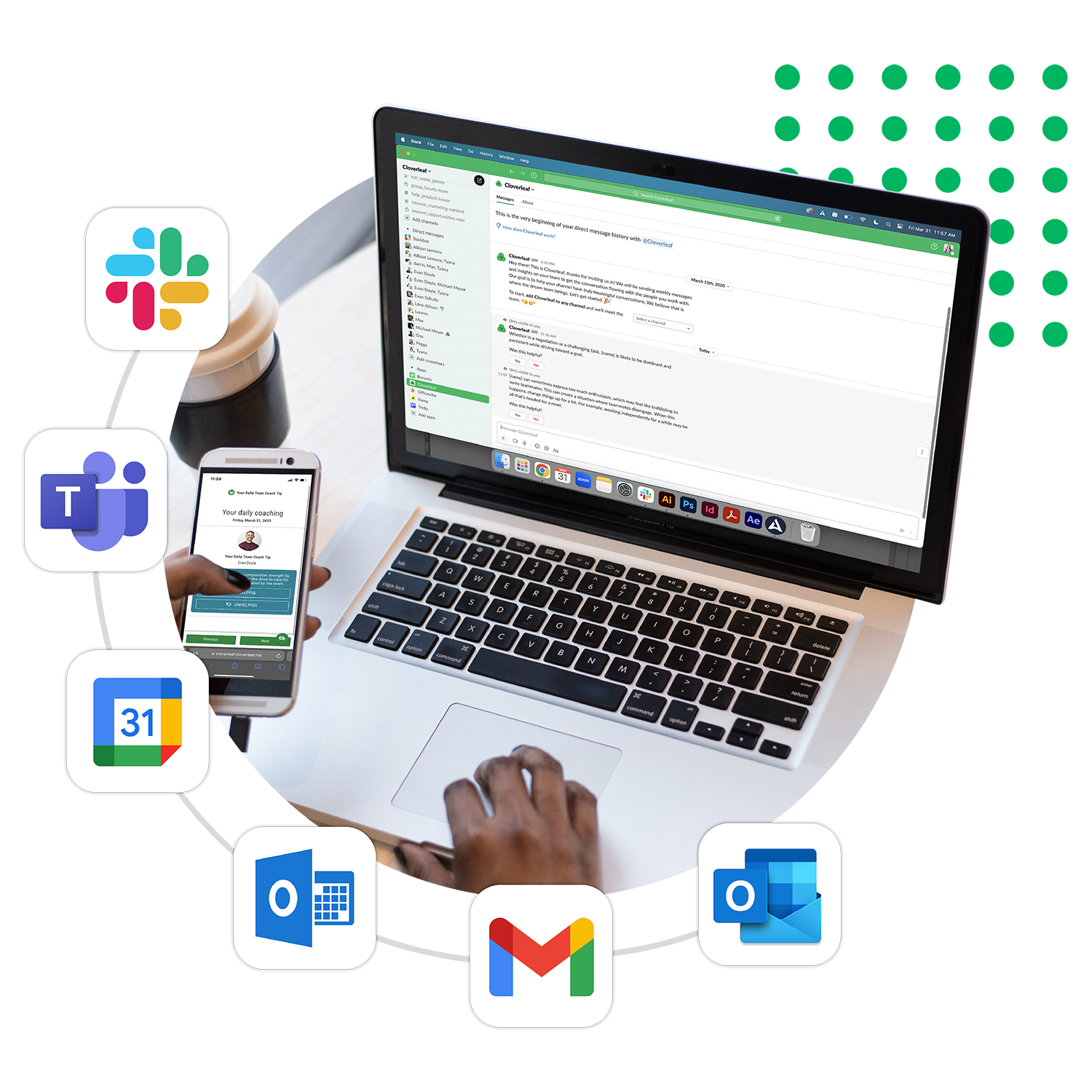
Making Learning In Context A Reality
At Cloverleaf, we’ve redefined continuous learning in the flow of work with Automated Coaching™. Here’s how we excel:
- Seamless Integration: Learning is embedded into the tools you already use, ensuring a smooth, disruption-free experience.
- Real-Time Insights: Receive tailored coaching precisely when you need it, aligned with your specific tasks and interactions.
- Engaging Microlearning: Continuous, bite-sized learning opportunities keep you engaged and enhance retention without overwhelming you.
Automated Coaching Outperforms Traditional Learning Approaches
Maximizing the Impact of Contextual Learning
- Improved Retention and Application: Ongoing, in-the-moment learning ensures skills are retained and immediately applied.
- Scalable and Inclusive: Personalized coaching is available to all employees, promoting equal development opportunities across the organization.
- Proven Impact: Trackable data showcases the tangible improvements in performance and ROI, validating the effectiveness of development initiatives.
Why We Believe Context Makes Continuous Learning Meaningful
At Cloverleaf, our commitment to learning in context is deeply rooted in rigorous research and continuous improvement. Here’s how our studies support this innovative approach:
Research and Commitment to Continuous Improvement
We recently conducted an analysis involving over 100 employees across 12 organizations, focusing on the impact of Automated Coaching™ on team communication and collaboration. The study revealed a 31% increase in these scores after just three months, demonstrating the effectiveness of contextual learning.
Further research with a client showed that engagement with our platform led to an 18% increase in employees feeling their skills were valued, a 36% increase in feeling recognized by team members, and a 36% improvement in perceived teamwork quality. These results underscore how embedding learning into daily workflows enhances both individual and team performance.
In a daily trends analysis, employees who engaged with Cloverleaf showed increased self-awareness and relational energy. This engagement resulted in more stamina, willingness to tackle new challenges, and higher quality teamwork, indicating that learning in context promotes continuous personal and professional growth.
Our qualitative interviews, validated by a global team of PhDs, highlight that users trust Automated Coaching™ for its unbiased, comprehensive insights. This trust facilitates significant improvements in self- and others-awareness, which are crucial for effective communication and collaboration within teams.
Development and Productivity No Longer Need To Compete
Learning doesn’t have to be disruptive. By integrating learning into the daily workflow, leaders can make sure that learning is continuous, personalized, and relevant to what people are doing right now. This approach tackles common problems with traditional training, like interrupting work, overwhelming people with too much information at once, and not being tailored to individual needs.
Key Takeaways:
- Embedded Learning: Development opportunities should fit seamlessly into the tools and routines that employees already use, minimizing disruption and making learning directly applicable.
- Continuous Reinforcement: Learning should be an ongoing process with regular reminders and tips to help people retain and apply new knowledge.
- Personalized Insights: Providing real-time, tailored insights makes learning more effective and relevant to each person’s specific situation.
- Scalability and Accessibility: Using technology like Automated Coaching™ allows us to offer coaching and development to everyone in the organization, not just a select few.
In this new era, we need a more scalable and “sticky” way to elevate collaboration across our organizations. It’s imperative. Collaboration is already making or breaking projects and organizations, and with the increasing pace of work, the need for effective collaboration is only growing. We must change our tactics to achieve consistently high-quality collaboration, or our personal and collective success—and wellbeing—will suffer.
Organizations face numerous challenges in this area. By and large, they don’t define, measure, or invest in collaboration effectively. While the term is often used, real investment and measurement reveal a wide variety of gaps. Collaboration, cross-functional teamwork, and related skills are rarely trained for or measured. When training does occur, it’s usually focused on individuals, typically leaders, who are then expected to apply these skills in teams that lack similar training. This siloed approach, if it exists at all, often falls short.
Investing in the quality of collaboration is often relegated to the category of “soft skills,” implying it’s less valuable. This perception persists because the industry hasn’t cracked the code on measuring collaboration effectively and proving its connection to profits. However, focusing on human skills like communication, empathy, and teamwork can transform the way organizations operate. By embedding these skills into daily practices, organizations can strengthen trust, innovation, and agility, ultimately turning human skills into a competitive advantage.
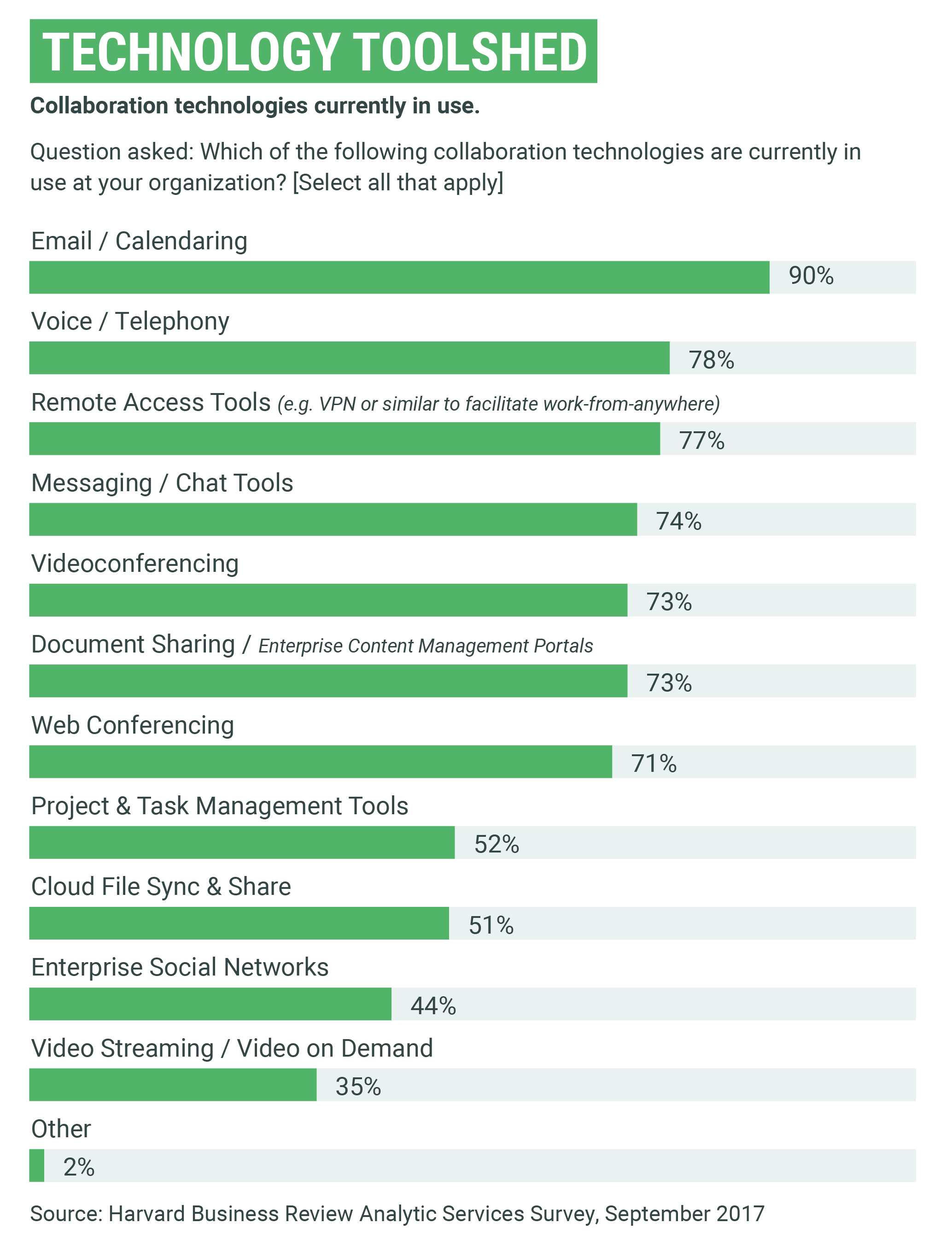
The Limitations of Traditional "Collaboration Tools"
In the broader technology market, many products are labeled as “collaboration tools.” However, these tools are mostly just communication or productivity tools. Few, if any, of the software tools currently classified as collaboration actually focus on the human (behavioral) element of collaboration.
Simply providing another channel to communicate doesn’t necessarily improve collaboration. In fact, it can often be a barrier by introducing confusion about where and how to communicate with each other. More channels can be more confusing if there isn’t a shared understanding of which channels to use and when. This often leaves people questioning where to expect a response from teammates. Email, Slack, or text? No one knows.
This Harvard Business Review survey found that while organizations use various tools to share words and files, these tools often fail to enhance true collaborative efforts. The survey revealed that while communication tools facilitate message exchange, they do not necessarily improve the effectiveness of these messages to create shared understanding and meaningful collaboration. We have too many ways to transfer messages and not enough support to build true relationships and quality communication.
We need new tools and approaches that address the work humans do to navigate our differences and achieve outcomes that build true value for the organizations we serve.

HUMAN SKILL PROGRAMS ARE HITTING LIMITATIONS...
5 THINGS THIS FREE RESOURCE WILL TEACH YOU
- Close the widening gap between learning and on-the-job application
- Overcome the tension of pausing productivity for development opportunities
- Integrate learning so it is actually in the flow of work
- The evolution of human skill development
- What Automated Coaching™ is and how it works.

Growing Collaboration Beyond Communication Tools
Current collaboration tools often fall short because they fail to address the core human elements of collaboration. Here are some specific issues:
- Overwhelming Channels: Multiple communication platforms can lead to confusion about where to communicate.
- Lack of Focus on Relationships: Effective collaboration requires tools that foster understanding and relationships, not just message exchanges.
- Missing the Behavioral Aspect: True collaboration involves navigating human behaviors and differences, which current tools do not adequately support.
The Need for Human-Centered Collaboration Tools
To truly improve collaboration, we need tools that:
1. Facilitate Understanding: Tools should help team members understand each other’s strengths, communication styles, and working preferences right in the flow of work. (Josh Bersin).
2. Build Relationships: Effective collaboration tools should focus on relationship-building and trust. (mckinsey.com)
3. Support Behavioral Changes: Tools should provide insights and nudges that help teams navigate differences and improve their collaborative efforts. Continuous learning and development platforms that offer real-time coaching and feedback can drive sustained behavioral change to improve collaboration.
Shifting the focus from mere communication to understanding and relationship-building, organizations can unlock the true potential of collaboration.
The Misnomer Of “Soft Skills“
Unfortunately, what we’re talking about here is often lumped into a broader category in the organizational context referred to as “soft skills.” This is a really annoying moniker on many levels for those of us who have dedicated our lives to improving people and organizational effectiveness. The word “soft” would seem to imply that it’s less necessary or less relevant than hard skills like software development or financial forecasting. This is also why many in talent management circles have started referring to these soft skills as “human skills”—an even more appropriate moniker in an era of artificial intelligence.
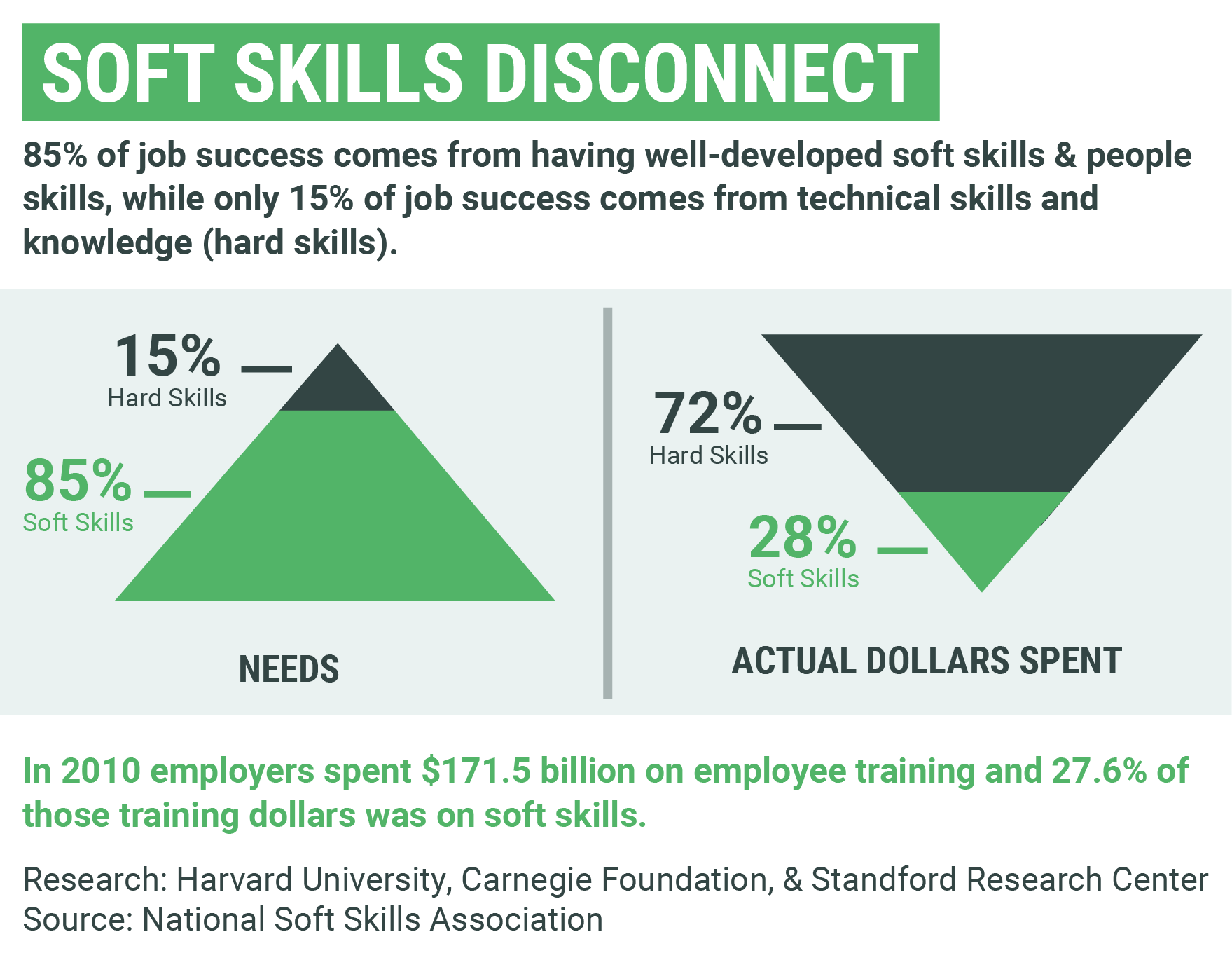
The Value of Human Skills
CFOs often like to gloss over these investments in soft skill training as frivolous and the most expendable when budget cuts are necessary. This disconnect is illustrated clearly when we examine where we are investing our talent development dollars versus what the organization and its leaders identify as the most critical skills for business success.
Despite the pervasive influence of Artificial Intelligence (AI) tools, human skills are the least likely to be displaced or replaced by AI. These skills offer exponential returns on investment compared to the incremental returns of most hard skills. For instance, learning how to use Excel better or adopting a new sales technique might improve efficiency marginally. However, understanding your teammates’ unique strengths can help avoid unnecessary conflicts and navigate differences toward significantly higher performance.
The Return on Investment (ROI) of Human Skills:
- Conflict Avoidance and Performance: A better understanding of human skills can help teams avoid conflicts and work more harmoniously, leading to higher productivity and better results.
- Market Relevance: Insights into human skills can guide the development of products and services that better meet customer needs, enhancing market success.
- Enhanced Customer Interactions: Skills in empathy, communication, and problem-solving improve customer support and sales effectiveness.
3 Challenges of Measuring Human Skills Impact
The disconnect between the investment in development dollars and the types of skills that have an outsized impact on performance boils down to measurement issues.
Challenges in Measuring Collaboration Health:
1. Lack of Standardization: There is no standardized way to measure soft skills across different organizations, making it difficult to benchmark or track progress uniformly.
2. Isolation of Impact: It is challenging to isolate the specific impact of a human skills intervention from other variables that influence performance.
3. Linkage to Financial Success: Drawing a direct and clear line between improvements in human skills and financial metrics like revenue growth or churn rates is complex and often indirect.
Let’s look at each of these in more detail.
1. The Need for Standardized Measurement in Human Skills
When discussing gross margin, businesses can quickly provide a percentage that reflects a standardized calculation. Unfortunately, such standardization for human skills and collaboration metrics is lacking. While we can measure turnover and engagement, how do we quantify collaboration, psychological safety, trust, or leadership?
Measuring Human Capital: SEC’s Steps
The SEC has recognized this gap. On August 26, 2020, they mandated that companies disclose their human capital resources in quarterly and annual reports. This includes any human capital measures or objectives that are key to managing the business.
Trends in Human Capital Reporting
Gibson Dunn’s study on the S&P 500’s compliance reveals significant variability in disclosures:
- Disclosures ranged from 109 to 1,995 words, averaging 960 words.
- 25% of companies avoided quantitative metrics, and 10% included only headcount numbers.
- Significant increases in disclosures on talent attraction, retention, compensation, diversity, health, and pay equity were noted.
There is no standardization in human capital metrics across companies. This variability underscores a lack of understanding of the value human skills bring to organizational success.
The SEC’s requirements are a start, pushing us towards more transparency and investment in people. International standards like ISO 30414 offer some guidance but remain voluntary.
By moving towards standardized measurements for human skills, organizations can better align investments with the factors that drive success, ultimately gaining more actionable insights into their most valuable assets: their people.
2. Isolating the Impact of an Intervention
Organizations invest $350 billion annually in learning and development (L&D) across various interventions, including online courses, in-person training, assessments, coaching, and more. How do we measure the impact of these development opportunities?
Consider an employee named Raj, who improved his performance after participating in multiple programs and moving to a new team with a new manager. How can we determine whether his performance boost was due to the training, the new team, or the new manager?
Current Measurement Practices: Many L&D leaders rely on surveys to gauge effectiveness:
- Surveys ask if the training was helpful.
- Surveys ask if managers are effective.
- Surveys ask if employees feel they have access to needed development programs.
Limitations of Surveys
- Sentiment vs. Metrics: Surveys measure feelings, not direct ties to business metrics like revenue or turnover.
- Survey Fatigue: People are tired of surveys, leading to low completion rates.
- Time-Based Approach: Pre- and post-intervention surveys measure short-term changes, but it’s hard to ensure lasting impact. Studies show that most training knowledge is forgotten within a week.
How can you know if someone’s behavior change will stick? Study after study shows that people forget most of what they learn in training courses within a week. How can development professionals truly measure if their programs create lasting change for months and years?
3. Linking Investments to Financial Success
How do investments in people translate into financial success? While studies show that companies investing in salary, benefits, or L&D are more productive, proving a direct link is tough.
How do investments in people translate into financial success? While studies show that companies investing in salary, benefits, or L&D are more productive, proving a direct link is tough. Demonstrating the ROI of collaboration is even harder. Before Organizational Network Analysis (ONA), quantifying collaborative activity was nearly impossible. Now, tools like Microsoft 365, Google Suite, Slack, Salesforce, and GitHub generate vast data showing who is connecting and communicating within teams.
ONA can identify key connectors, highlight areas of isolation, and pinpoint communication breakdowns. However, it still doesn’t easily link these activities to financial metrics. It measures communication quantity, not quality. High volumes might indicate miscommunication, gossip, productive brainstorming, disengagement, or efficient alignment.
Organizational Development leaders face challenges in proving the impact of leadership programs on emotional intelligence and psychological safety, which are crucial for reducing turnover, increasing engagement, and accelerating innovation. Surveys can gauge sentiment but often fail to show direct ties to financial outcomes. This gap makes it hard to secure budget approval for development initiatives without leaders’ belief in the value of investing in people.
Unlocking the Potential of Quality Collaboration
Valuable collaboration is under-invested because we think of it in terms of quantity or channels rather than quality. We lack a common language and numerical proof linking it directly to profit. However, effective collaboration leads to profit and enhances the quality of life for employees and customers.
The convergence of macro-trends, SEC requirements for human capital considerations, and technological advancements present an opportunity to empower effective human skill interventions and measure high-quality collaboration’s impact.
The explosion of data and new techniques promises a future where we better understand how collaboration impacts productivity, innovation, and value creation. For now, approaches remain inconsistent across companies and teams.
At Cloverleaf, we have a front-row seat with millions of people in tens of thousands of teams across hundreds of organizations both large and small, for what is working and what is ineffective in collaboration. We built Automated Coaching around proven concepts that work, grounded in decades of research and validated by real-world applications, resulting in quality collaboration, value creation, and life-changing outcomes. To see Cloverleaf in action or schedule a demo, click here.
Great leadership isn’t just about technical skills—it’s about connecting with your team on a deeper level. Gallup’s research tells us that how leaders interact with their teams directly impacts motivation, engagement, and retention. The message is clear: self-aware leaders who tailor their communication and collaboration strategies can truly connect with their teams and unlock their full potential.
The big question is: Can emotional intelligence be developed through training, or does it solely come from experience and feedback? While you can’t change who people are at their core, you can certainly guide them to better behaviors.
Each leader, team, and organization has its own unique challenges. That’s why one-size-fits-all emotional intelligence training often falls short. Leaders need insights that are tailored to their specific situations and can be applied right away. They need personalized, actionable strategies that make a real difference with the people they’re interacting with in the moment.
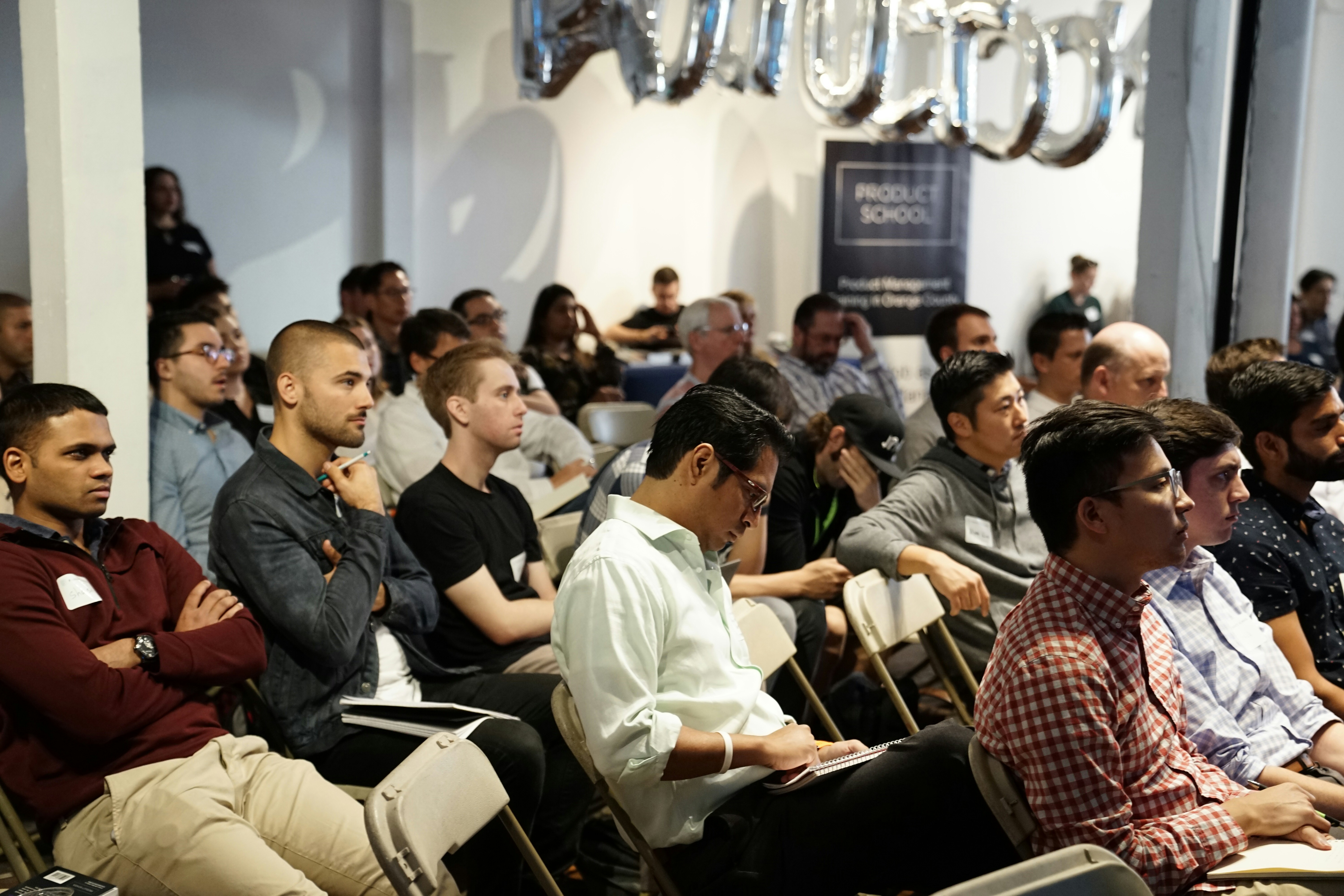
Why Personalized Emotional Intelligence Training Matters To Leaders
Traditional training and development efforts certainly have their place, offering valuable insights and skills. However, building self-awareness—a cornerstone of emotional intelligence—requires efforts that are deeply personal and tailored to the individual. Similarly, encouraging leaders to become more attuned to their teams can’t rely on generic team dynamics; it must be focused on their unique team.
Why One-Size-Fits-All Training Falls Short
Personalized training helps leaders apply emotional intelligence concepts in real-world situations. It can empower leaders to focus on areas where they need the most development to strengthen their emotional intelligence and overall effectiveness.
Lack of Practical Application: One-off events or workshops, while engaging, often miss the mark on practical application and continuous action. Leaders might leave with great ideas, but without the means to practice and integrate these new behaviors into their daily routines, the impact is minimal. Emotional intelligence requires time and sustained effort. Real change happens through repeated practice and reflection, which generic workshops simply can’t provide.
Finite Experience: Without ongoing support, even the best workshops remain limited experiences, unlikely to drive lasting development. Emotional intelligence isn’t something you can master in a single session; it’s a continuous journey. Leaders need ongoing, personalized insights that help them apply what they’ve learned in real-world situations, adjusting and refining their approach as they go.
The Need for Personalization
Emotional intelligence requires continuous, personalized learning for individuals to understand their own tendencies and those of others. Training must provide actionable strategies that leaders can integrate into their daily interactions to drive deep, lasting change.
To ensure emotional intelligence training is behavior changing it must go beyond role-based content. It must provide personalized, actionable strategies directly relevant to their responsibilities and the people they work alongside. Only then can Talent Development leaders create the kind of deep, lasting change that makes a real difference for leaders and their teams.

Want To Develop More Emotionally Intelligent Leaders?
Find Out How To Quickly:
- Close the gap between learning and on-the-job application
- Personalize growth to individual strengths and needs
- Integrate learning so it is actually in the flow of work
- Develop human skills fast enough to solve business problems
- Prove the ROI of your development programs
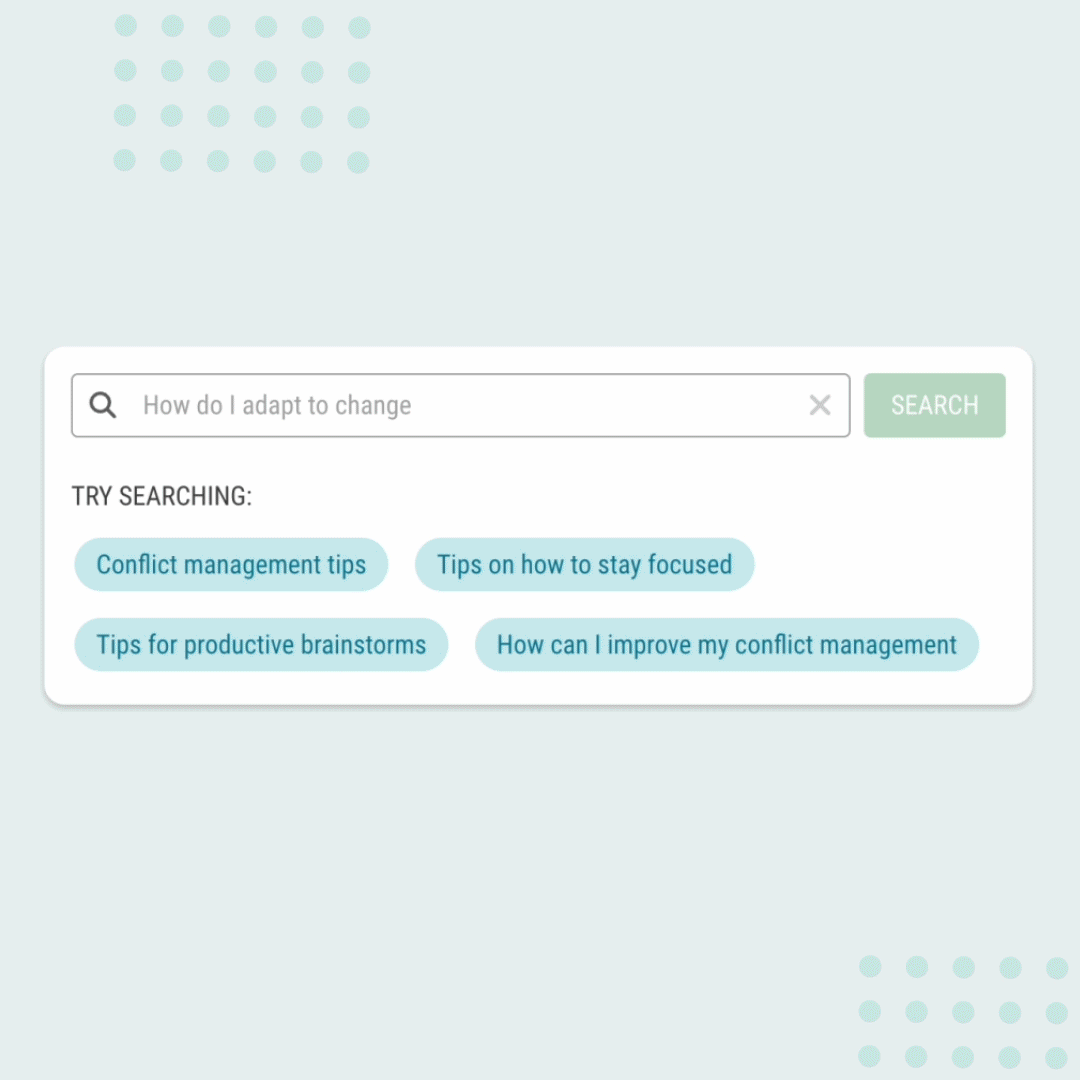
Bring EQ Development To Life with Data-Driven Insights
What if leaders had a personal coach (not a human or chatbot) offering real-time insights tailored to each workday challenge, helping them develop their emotional intelligence seamlessly?
That’s the power of Automated Coaching™. By leveraging data from trusted workplace assessments, it provides ongoing, specific, and practical insights tailored just for you. This approach helps you understand your own behaviors and those of your team, ensuring you can effectively apply emotional intelligence in real-time situations.
Traditional training programs often lack the continuous support necessary for lasting change. Automated Coaching™ fits effortlessly into daily routines, offering valuable insights in just a few minutes each day. This real-time feedback helps leaders immediately apply what they’ve learned, driving meaningful development.
Real-Time Coaching Insights Leads To Immediate Impact
For instance, if you receive an insight that you process information quickly while others need more time, you can adjust your presentation style to be more inclusive. Similarly, a reminder about a team member’s strength can prompt you to involve them in a project where their skills will shine. Discussing these insights in one-on-one meetings can also help delegate tasks effectively and support team growth.
Research supports the effectiveness of continuous, personalized coaching. For example, a meta-analysis published in 2021 found that psychologically informed coaching approaches significantly improve self-awareness, adaptability, and overall workplace performance (Emerald Insight).
Deloitte’s research indicates that coaching in the flow of work, where feedback is integrated into daily activities, enhances the application of insights and leads to more effective performance improvements (Deloitte United States). Josh Bersin also emphasizes that learning in the flow of work allows employees to apply what they learn immediately, making the development process more practical and impactful.
Automated Coaching™ reinvents how leaders develop their emotional intelligence because it provides a more responsive and tailored approach. Insights can be instantly applied to ensure that EQ development is a practical, ongoing journey.
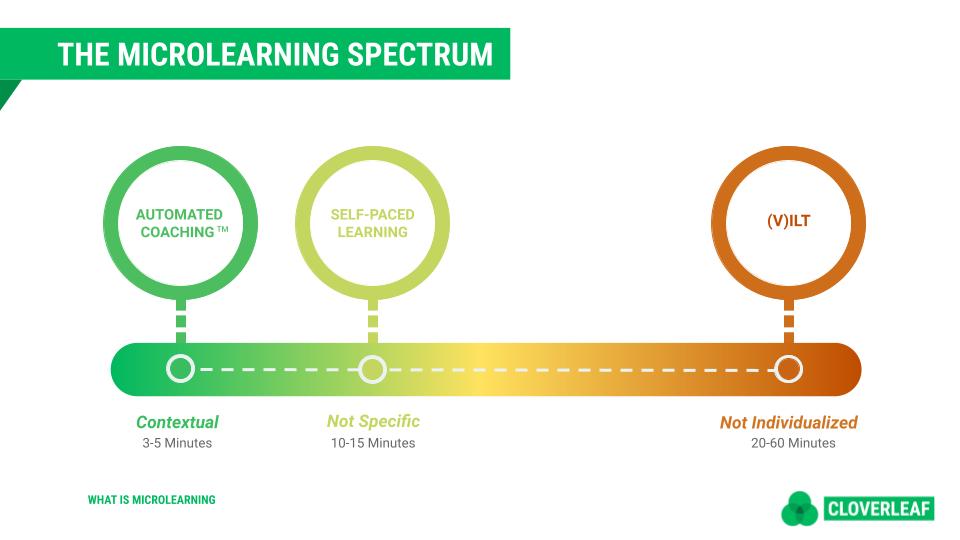
4 Actionable Steps for Leaders To Develop & Practice EQ
Emotional intelligence is not just about understanding your own emotions, but also about recognizing and responding to the emotions of others. Here are some actionable steps to help you grow and apply emotional intelligence within your team.
1. Know and Understand The People On Your Team
Understanding your team members’ preferences is crucial for effective leadership. Instead of overwhelming them with constant questions, observe their interactions and ask occasional, targeted questions to discover their preferred leadership style. Do they thrive with hands-on guidance, or do they prefer autonomy with periodic check-ins? Recognizing these preferences helps tailor your approach to each individual.
2. Craft Personalized Onboarding Experiences For New Hires:
When welcoming new team members, a simple onboarding form can provide valuable insights into their preferences and needs. Consider including questions like:
- Feedback Preferences: How do you like to receive feedback?
- Recognition Comfort: What kind of recognition makes you feel appreciated?
- Motivation Drivers: What motivates you the most?
- Support During Challenges: How would you like to be supported when you’re facing challenges?
- Professional Development: What areas would you like to develop professionally in the next year?
These questions help you tailor your leadership style to each new hire, ensuring a smooth integration into the team and fostering a supportive environment from the start.
3. Encourage Growth Through Meaningful Feedback
Initiate regular one-on-one feedback sessions to foster open communication. This demonstrates your commitment to valuing your team’s input and your dedication to growth as a leader. Tailor your questions to address their specific needs and experiences. Here are a few examples:
- Reflect on Support:Can you share a moment from the past month when my support was most effective for you?
- Identify Additional Needs:What support or resources could I provide that you currently feel are lacking?
- Reduce Overwhelm:Are there any aspects of my support that you find overwhelming or unnecessary?
- Strengthen My Leadership:What is one thing you think I could do differently to better support you as a leader?
4. Embrace Constructive Criticism to Build Trust
Constructive criticism is a powerful tool for growth, but it requires an open mind and patience. By showing your team that you can handle feedback with grace, you set a strong example and build a culture of continuous improvement. Here are some ways to effectively embrace constructive criticism:
- Be An Active Listener:
Give your full attention to the feedback without interrupting. This shows that you respect and value the other person’s perspective. - Reflect Before Reacting:
Take a moment to consider the feedback before responding. This helps you provide thoughtful responses rather than reacting defensively. - Act on Feedback:
Demonstrate your commitment to growth by implementing changes based on the feedback. This shows your team that you value their input and are dedicated to improving. - Close the Loop:
Follow up with the person who gave you the feedback after making changes. This shows that you are committed to continuous improvement and value their contribution.
Scale Team-Wide EQ Development With Automated Coaching™
While these actionable ideas are beneficial, Automated Coaching™ takes leadership development to the next level by tailoring approaches to enhance emotional intelligence (EQ) more effectively. When an entire team uses Cloverleaf, everyone benefits from the personalized insights provided by Automated Coaching™, spreading the responsibility of growth beyond just the leader. This method makes developing the EQ of an entire team both scalable and practical.
Each team member receives unique insights from Automated Coaching™, empowering them to communicate more effectively with their colleagues and leaders. As self-awareness increases individually and collectively, the team’s overall EQ improves, leading to a more harmonious and emotionally intelligent workplace. This shared journey not only strengthens team dynamics but also boosts performance and collaboration across the board.
The Future of Emotionally Intelligent Leadership
Michelle King, PhD, author of How Work Works: The Subtle Science of Getting Ahead Without Losing Yourself (2023), underscores that “75% of career success hinges on advanced social and emotional skills, while only 25% depends on technical know-how.” This makes sense because while technical skills can be acquired, mastering social and emotional skills demands continuous effort and dedication.
Whether you’re an individual contributor or a senior leader, continuously evolving your emotional intelligence is key. Michelle offers several strategies for this evolution, pointing out that “70% of all learning happens on the job.” This highlights the importance of constant, informal development.
This is where Automated Coaching™ steps in. It provides ongoing, personalized learning integrated into your daily work, boosting both self-awareness and the ability to understand others. Automated Coaching™ fits naturally into your routine, delivering timely and relevant insights that help you and your team grow together.
Learning in the flow of work is more than just a buzzword—it’s a transformative concept that, when actually experienced, can truly turn new insights into actual development. We’ve all felt the disruption of stepping away from our daily tasks for a training session or conference. While these traditional methods have value, they often lack immediate applicability.
When learning is truly in the flow of work, it shortens the time between insight and action. The integration of learning moments that are relevant to one’s work into their daily tasks, minimizes interruption. This continuous, contextual learning builds strength, awareness, and encourages a growth-oriented culture. The real impact of learning multiplies when it is actionable because it is timely. Theoretical knowledge can easily be forgotten in the busyness of work, but when learning translates into tangible, value-adding actions, it becomes indispensable.
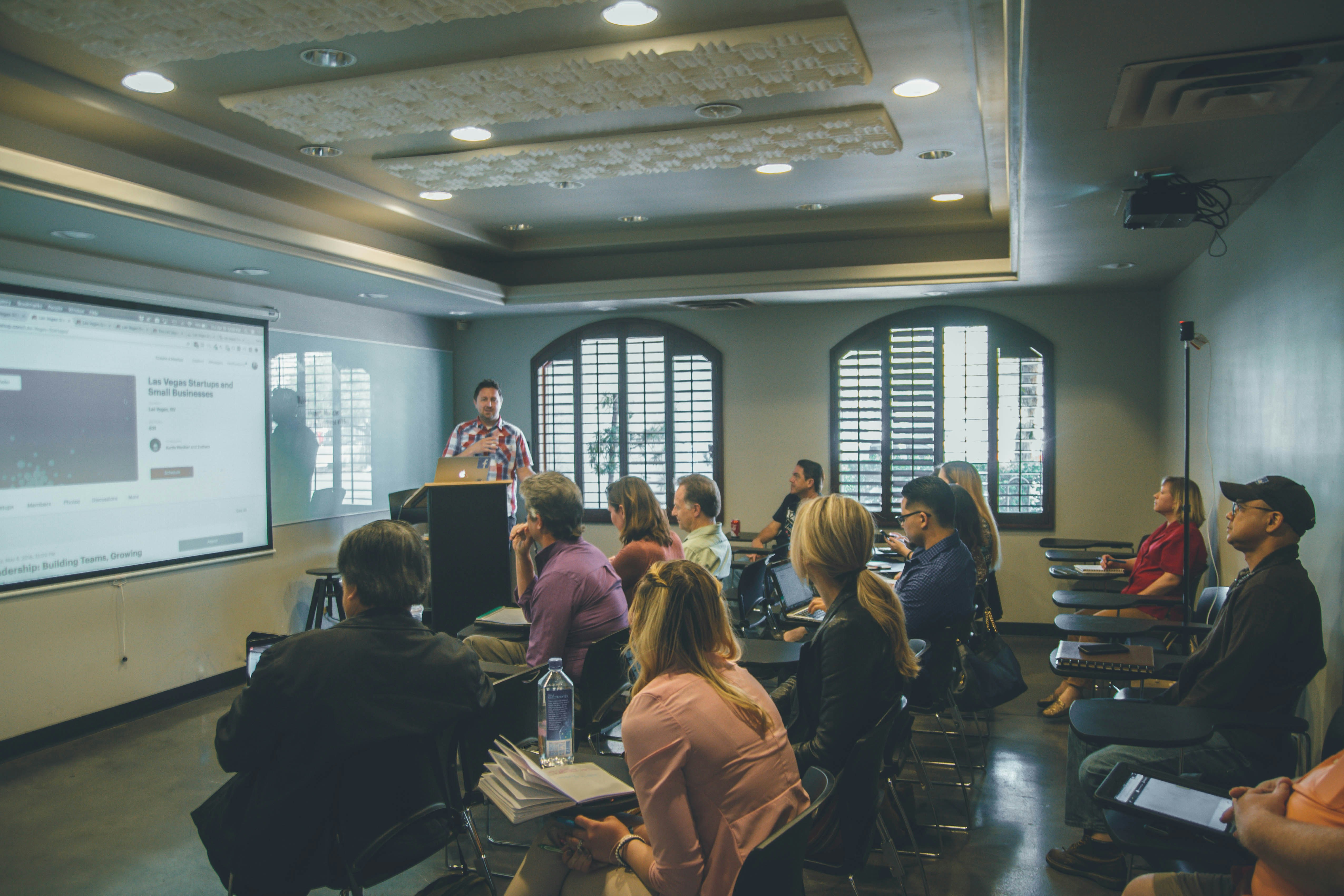
Why Learning In The Flow Of Work Is Still Broken
One of the biggest pitfalls of workplace learning is the misconception that it must be confined to traditional training sessions. In reality, learning can and should take many forms. Offering diverse channels and methods creates an engaging learning environment that resonates with a broader audience.
Consider the dynamics of a live or virtual learning session. Extroverts, thriving on group interactions, often dominate the conversation, actively participating and drawing energy from the experience. In contrast, introverts may find these settings draining, limiting their engagement and the value they derive (Cain, 2018).
Applying practical knowledge from traditional learning can be a significant challenge, especially without structure or accountability. Often, after a training session or course, people return to a mountain of emails and tasks, with catching up becoming their first priority. This scenario can lead to newly acquired knowledge being tucked away into one’s mental filing cabinet, rarely accessed again. This is where Hermann Ebbinghaus’s research on the Forgetting Curve comes into play. He found that people forget about 50% of new information within an hour and up to 90% within a week without reinforcement (Ebbinghaus, 1885). This insight underscores the need for continuous learning and regular reinforcement to make knowledge stick.
Traditional learning also struggles with personalization. While it can provide a broad understanding of topics and strategies, it often fails to meet individual needs effectively. This isn’t to undermine its value—it can spark meaningful discussions, help overcome challenges, and offer a refreshing break from daily routines. However, recognizing its limitations is crucial for evolving our approach and ensuring every learner finds their path to growth and success.
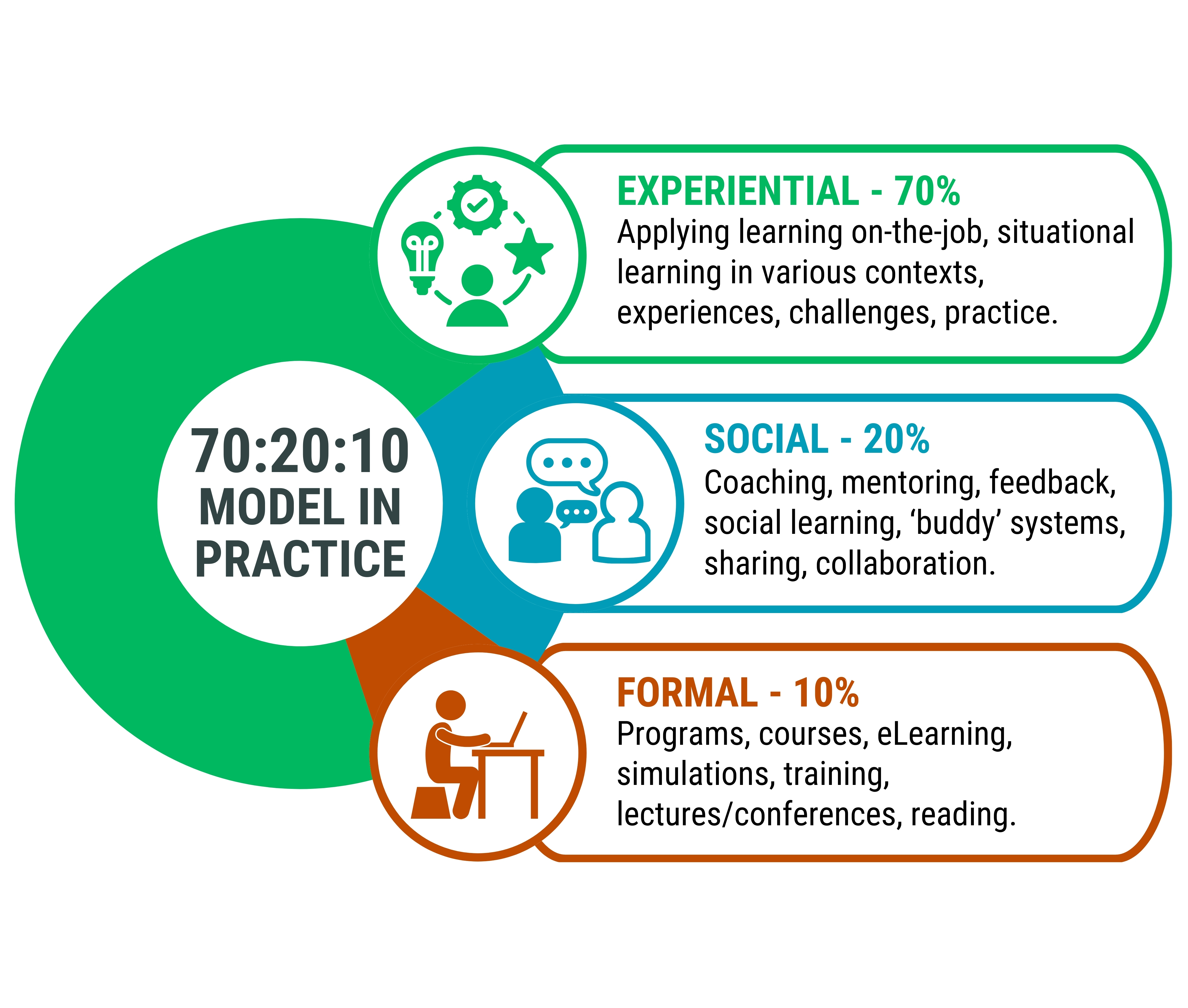
The Disconnect Between Learning and Development
On top of that, the 70-20-10 model of leadership development suggests that 70% of learning comes from on-the-job experiences, 20% from interactions with others, and only 10% from formal educational events (McCall, Lombardo, & Eichinger, 1996). As it turns out, gaining more knowledge is the smallest piece of the growth process. This familiar Talent Development model illustrates that the majority of development happens when
learning is applied in the day-to-day of work.
Learning in the flow of work doesn’t always translate into drag-and-drop self-paced courses or consuming short pieces of content in video or written format. These methods might not be personalized or tailored to individual needs.

HUMAN SKILL PROGRAMS ARE HITTING LIMITATIONS...
5 THINGS THIS FREE RESOURCE WILL TEACH YOU
- Close the widening gap between learning and on-the-job application
- Overcome the tension of pausing productivity for development opportunities
- Integrate learning so it is actually in the flow of work
- The evolution of human skill development
- What Automated Coaching™ is and how it works.
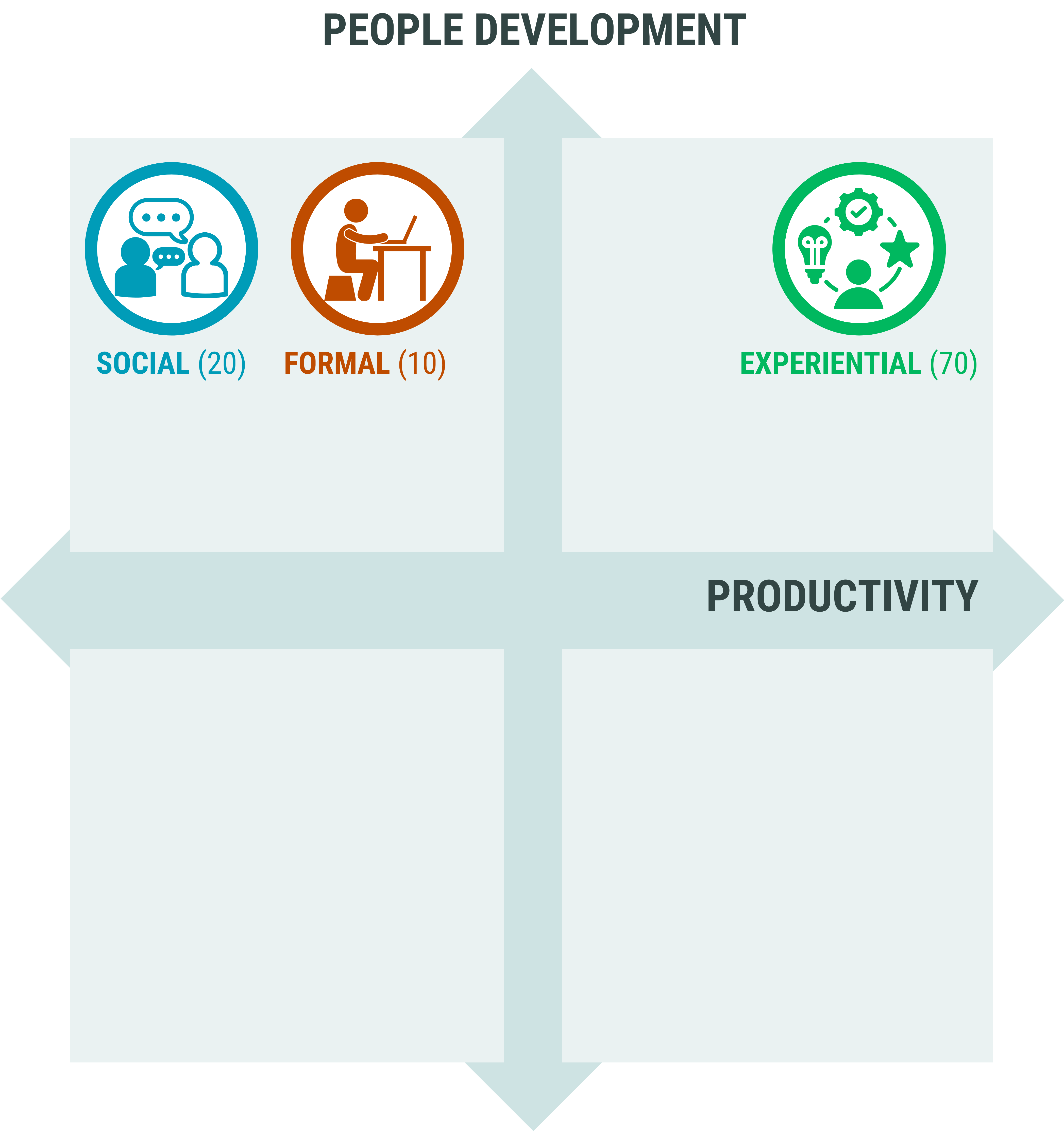
Learning In The Flow Of Work Must BE About The Individual & Their Context
Cloverleaf tackles these challenges head-on by providing personalized learning within the flow of work. This approach minimizes disruption and facilitates the immediate application of practical content, making learning stick. Learning retention increases dramatically when helpful information can be used right away.
For example, consider the power of Automated Coaching™. It requires just 1-2 minutes a day, allowing for quick reflection and application. This consistent source of personalized coaching makes learning concise, meaningful, and specific to their exact work situation. Over time, it builds the muscle of self and team awareness, enabling individuals to communicate and collaborate more effectively based on their natural strengths.
To truly maximize the impact of formal learning, Talent Development leaders need support that only technology makes possible. Human beings can’t possibly scale or provide continuous learning in the flow of work so that people can apply it, but technology-derived micro-nudges certainly can.
Cloverleaf ensures that learning is not just theoretical but practical and immediately relevant. We build Automated Coaching specifically with four pillars that turn learning opportunities into true development for everyone in an organization:
- Personalization
- Scalability
- Continuous Learning
- Proof of Impact
With massive technological advancements, so much is possible today that was implausible a mere 3 years ago. All of the great research on how people work together to create the best outcomes (think: EQ, Human Skills, psychometrics, leadership, collaboration, etc.) can now be partnered with technology to make learning not only possible through small daily moments, but actually attractive and deeply appreciated by people in every level of an organization.

Effortless Learning Inside Your Favorite Tools
One way Cloverleaf makes learning so seamless is through its integration with tools that people already use every day. From email to MS Teams to Slack, Cloverleaf adds an extra dimension of intentionality to your day. As you look at a stacked day of meetings on your calendar, you might think you don’t have time to learn and develop. But by integrating your calendar with Cloverleaf, you’ll receive short, impactful tips about collaborating with who you are meeting, making preparation for conversations simple and personalized.
From Theory to Practice: Cloverleaf’s Impact
Cloverleaf’s Automated Coaching™ can also integrate into existing learning initiatives to help individuals absorb and apply learning to themselves and their teams. In a case study involving over 200 leaders, ranging from the C-Suite to first-time managers, participants learned coaching skills over six months with access to Cloverleaf.
Leaders met every other week for short, impactful coaching skills training and were then tasked with practicing these skills with their teams. Each day, participants engaged with automated coaching tips about themselves and their team members. Here’s how some participants reflected on how Cloverleaf supported their learning journey:
- Cloverleaf’s automated coaching has made me more self-aware of my listening style and how my conflict styles are to avoid potential pitfalls when talking with others.
- Understanding different personality types and how to communicate with them makes a huge difference in my conversations, especially when it comes to conflict.
- Cloverleaf gave me the confidence I needed to address challenging conversations with all the self-tips they gave me.
- By reading my coaching tips daily, it started my day thinking about coaching. I also use the tips about others I interact with to help me in my dealings with them so I find that very helpful.
- Cloverleaf sends me emails each morning with new content each day. I read them every morning and take them into my work day! They’ve been incredibly insightful and provided me with guidance I apply to myself. For example, sometimes I defer to others and their thoughts rather than my own. Cloverleaf reminded me of this and provided guidance on how to find opportunities to give my thoughts!
These reflections from users highlight how Cloverleaf makes a real difference. By including personalized coaching in their daily routines, leaders were able to strengthen their self-awareness, improve communication, and handle challenging conversations with more confidence. This brief snapshot of user experiences indicates individual growth and a more collaborative and effective team environment. The spot-on insights and daily tips ensure that learning is continuous, actionable, and deeply personalized.
The Future of Workplace Learning Is Personalization and Relevance
To stay ahead of the learning curve and effectively develop a multi-generational workforce, learning and people strategy leaders must embrace innovative approaches to integrating learning into the flow of work. This means shifting the focus from broad, generalized content to personalized, relevant learning experiences that cater to diverse needs and preferences.
Today’s workforce includes many individuals who have grown up with technology as an integral part of their educational experience. Traditional learning methods, designed before the digital era, often fail to meet the expectations and habits of this tech-savvy generation. According to the 2024 Workplace Learning Report by LinkedIn Learning, there is a significant shift towards personalized and flexible learning solutions to meet modern employees’ expectations. Therefore, it is crucial to reevaluate learning strategies and ask, How are we addressing the learning needs of today’s workforce?
Providing learning opportunities within the flow of work is becoming increasingly essential, especially in an environment where many teams are hybrid, remote, or dispersed. The Deloitte Insights report on the future of work in technology highlights the importance of integrating continuous learning into daily work processes to keep up with rapid technological advancements and changing workforce dynamics. It emphasizes that learning in the flow of work enhances employee engagement and productivity.
Incorporating learning into the flow of work not only keeps organizations competitive but also supports the growth and success of a diverse and dynamic workforce. It’s time to move beyond traditional learning models and adopt strategies that meet the evolving needs of today’s employees.
For more information about how Automated Coaching is a powerful microlearning tool, download: Talent Development In The Age Of AI: Overcoming the Limitations of Traditional Learning
Corporate learning is experiencing a shift towards more agile and effective training. Google Trends data from the latter part of 2023 reveals a pronounced spike in interest in “microlearning,” a term that has steadily gained prominence since July 2010. This surge in interest reflects a growing recognition among organizations that learners need new ways of accessing and receiving information so that it is easier to retain and apply.
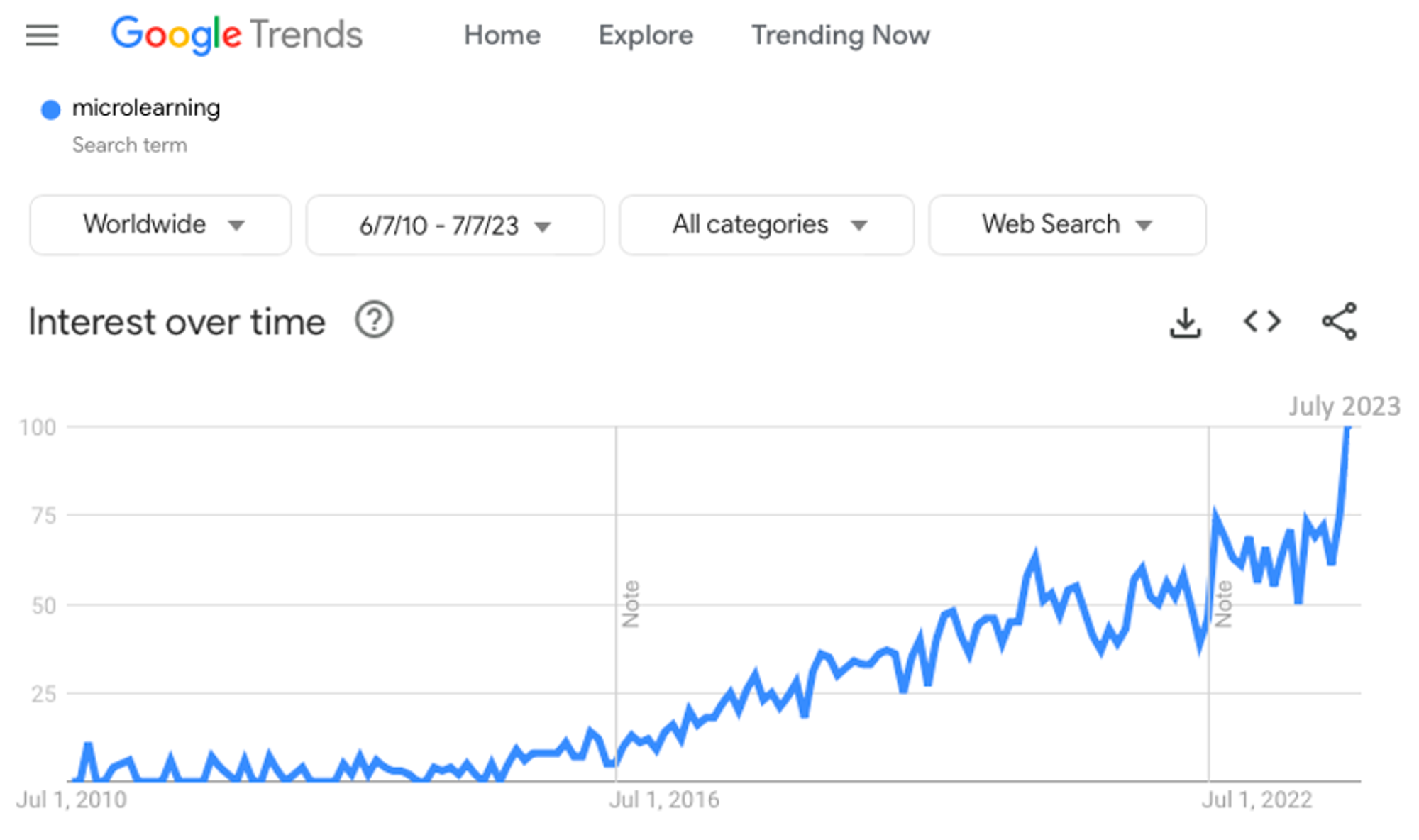
The concept of microlearning is that it is a quick and focused learning experience. Delivering content in small, digestible bursts provides more flexibility for employees with on-demand learning that better integrates into their workflows.
The increase in microlearning signifies more than just a trend; it reflects a strategic pivot in how organizations approach talent development. With technology, platforms have evolved from basic educational tools into integral components of business strategy.
What is Microlearning?
Microlearning revolves around delivering small, digestible content morsels to learners, allowing them to seamlessly integrate learning into their daily workflow. Unlike lengthy training sessions that disrupt office routines, microlearning can be consumed in as little as 3 minutes or as long as 15-20 minutes. By repeating these microlearning moments over time, individuals can effectively learn and internalize concepts relevant to their roles.
Microlearning is not just about short learning sessions; it represents a fundamental shift in the way knowledge is delivered and absorbed in the workplace. It focuses on delivering concise, targeted content in manageable segments.
Why is Microlearning Strategic for Talent Development Leaders
1. Retention and Application: The bite-sized nature of microlearning helps in combat issues like the forgetting curve, as learners engage with key concepts in short, frequent bursts.
2. Adaptability to Changing Needs: Microlearning is flexible by nature and allows learners to access when it is best and most advantageous for them.
3. Learner Engagement: Content that is quick to consume and designed to integrate into a learner’s day makes it easier to digest and more appealing access, particularly among younger employees.
4. Cost-Effectiveness: Reducing time spent away from work and the need for extensive training resources or coaches, microlearning can deliver high-impact learning with less cost.

HUMAN SKILL PROGRAMS ARE HITTING LIMITATIONS...
5 THINGS THIS FREE RESOURCE WILL TEACH YOU
- Close the widening gap between learning and on-the-job application
- Overcome the tension of pausing productivity for development opportunities
- Integrate learning so it is actually in the flow of work
- The evolution of human skill development
- What Automated Coaching™ is and how it works.
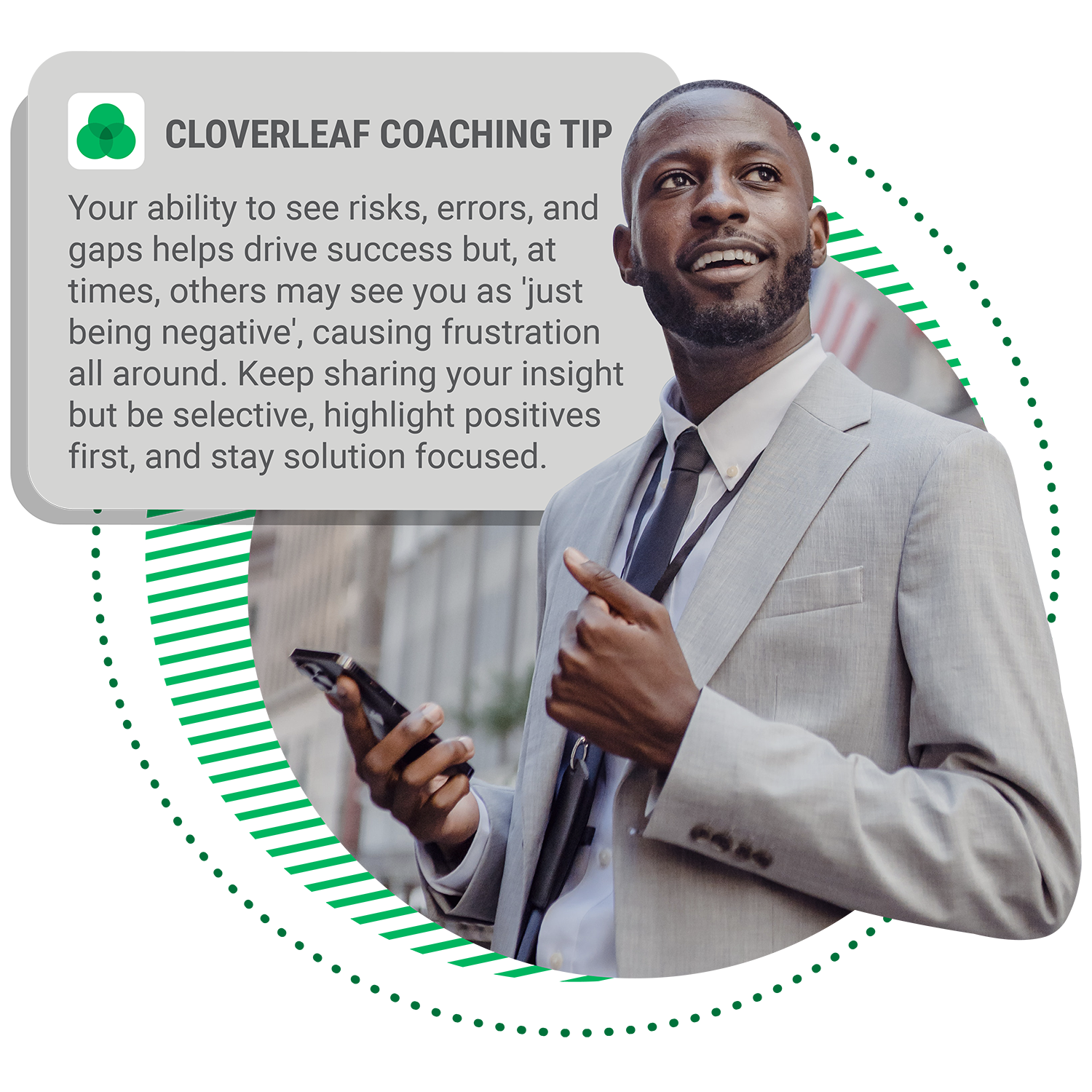
Microlearning & Automated Coaching: Personalizing Learning at Scale
Traditionally, microlearning has taken various forms, including short videos, e-learning modules, audio clips, readings, and infographics. While these formats are beneficial, they often lack true personalization that is particularly unique to the individual beyond their role. However, Automated micro coaching—a form of microlearning, is tailored content that is highly personalized to individuals and their teams. It is learning that meets you where you are and is about who you are.

AUTOMATED COACHING IS MICROLEARNING THAT ACCELERATES BEHAVIOR CHANGE
Traditionally, microlearning has taken various forms, including short videos, e-learning modules, audio clips, readings, and infographics. While these formats are beneficial, they often lack true personalization that is particularly unique to the individual beyond their role. However, Automated Coaching—a form of microlearning, is tailored content that is highly personalized to individuals and their teams. It is learning that meets you where you are and is about who you are.
How Can Teammates Use Automated Coaching?
Suppose a new team member joins a team, and through automated coaching insights, managers or teammates can learn about their preferred communication style. Equipped with this knowledge, individuals can adjust their own approach to collaborate more effectively with them.
For instance, I might be someone who enthusiastically dives into discussions or meetings without prior planning, whereas my new colleague prefers receiving agendas in advance or starting meetings with an overview of topics to be discussed. As I receive more automated coaching insights about my team members, I can adjust my behavior to enhance collaboration and the results we produce together.
Automated Coaching Is Non-Disruptive By Nature To The Flow of Work
One of the most attractive aspects Automated Coaching is that it actually a microlearning platform. Each insight is designed to be digested in approximately two minutes, making it possible to quickly consume and reflect upon without breaking the flow of your workday. This relevancy to both individual and team contexts means that insights can immediately spark thoughts or actions that enhance daily productivity.
A Microlearning Platform That Creates A Proactive Workday:
Starting one’s day by receiving automated coaching insights encourages a proactive approach to tasks and opportunities for collaboration. People can’t possibly remember everything about all of their team members every day or even have all of their own strengths top of mind. Automating the process helps keep critical information about dynamics with teammates and personal strengths at the forefront to influence better decision-making and interaction throughout the day.
Reduce Disruption So That Learning Is Seamless:
Unlike other microlearning platforms that might require setting aside dedicated or extended time for consumption, Automated Coaching is accessible and on demand. It is done-for-you learning that does not require the learner to listen to anything or even complete an action. Whether you need a quick tip before a meeting or a reminder about a team member’s communication style, it’s available right when you need it, integrating seamlessly into your workflow.
Dual-Direction Accessibility:
The great part about Automated Coaching is that it can be pushed out to you and pulled towards you. It is nudge learning that comes to you and is also at your fingertips anytime you need it. This feature allows for customizing personalized preparation, which is especially useful in strategizing for upcoming interactions or feedback sessions.
Relevant Learning That Impacts Culture:
The ongoing, dynamic personalization of Automated Coaching ensures that learning is relevant and useful and continuously lives as a creative resource to support ongoing self and team awareness. As individuals take intentional action resulting from engagement with Automated Coaching, it can lead to a positive domino effect on team cohesion and culture.
Maximizing Microlearning Platforms For Engagement, Knowledge Retention & Integration
Easy, quick learning that provides value, makes repeating small acts attainable for people, and will lead to higher learning potential. This is not to say that live or virtual training can’t be valuable for team building or even changing up the environment, but for longer-term knowledge retention, much of what people learn in a finite training session is quickly forgotten.
This is also known as The Forgetting Curve. Within 1 hour, people forget 50% of new information. Within 1 day, they have forgotten 70%. Within 1 week, they have forgotten 90% of what they learned. This means more frequent touchpoints that are personalized and bite-size can have a much greater impact on learning retention.
One of the most valuable aspects of Automated Coaching is that it’s not an LMS. Instead, coaching insights can be delivered through tools people are already familiar with and using every day. This microlearning approach is different because it truly embeds the learning in the flow of work and enables people to remain in the context to apply the learning over time.
Reinforce Training with Little Lift
An advantage of Automated Coaching is that it does not require any development or the work of an Instructional Designer. Automated Coaching is “done for you” microlearning that can greatly impact productivity, collaboration, soft (essential) skill development, communication, and self/team development.
People and learning leaders can be confident knowing that microlearning people take action on is at the fingertips of their leaders, managers, and teams.
For learning and development leaders, utilizing microlearning means embracing a future where development is continuous, personalized, scalable, and aligned with strategic business goals. With microlearning platforms, the goal is not just to provide information but to ensure that learning translates into positive action.
For more information about how Automated Coaching is a powerful microlearning tool, download: Talent Development In The Age Of AI: Overcoming the Limitations of Traditional Learning
